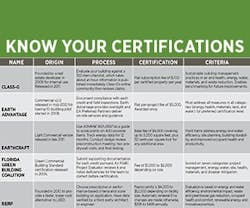The expense, time commitment, and work required by the first crop of green building certifications have spurred the development of a new field.
These designations, which have risen to prominence within the last several years, range from whole-building programs designed for speed and affordability to hyper-local ones that focus on one climate, region, or state. They haven’t been around as long as LEED or Green Globes, but they’re carving out a niche in the market.
Curious about the alternatives? A certification reflecting your unique situation might be your ticket to green recognition.
Quick, Low-Cost Measurement
Two certifications – the Society of Environmentally Responsible Facilities (SERF) and Class-G (a reference to the office space grading system) – were founded by building and real estate professionals to provide a faster, lower-cost alternative to LEED.
Applying for these two requires you to score your own building and have the results verified – SERF by a third-party architect or engineer, Class-G by their community of fellow participants who can red-flag questionable claims. Self-assessment cuts down on the need for certification specialists, thereby reducing costs.
“We were able to condense each line item on the checklist to 12 words or less. We wanted to create the Twitter of sustainability programs,” explains Mike Embrescia, director of Class-G. “One of the problems most companies have is that they lack the human and financial capital to bring on an architectural design firm and engineers to sift through pages and pages to prove their sustainability.”
Class-G streamlines certification for multiple locations instead of requiring fully separate applications for each, Embrescia says. It highlights two types of practices – the green actions you’re currently taking, plus a wish list of things you plan to do in the near future.
Conversely, SERF offers two certification tracks – prescriptive and performance-based – and lets you choose which one best represents your facility’s sustainability commitment.
Size-Specific Certifications
Some programs cater to small buildings. Earth Advantage, for example, covered buildings of 10,000-70,000 square feet in its 2008 pilot, though it has since expanded to new and major renovations under 100,000 square feet.
Like BOMA 360, Earth Advantage places a large emphasis on operations and maintenance. However, it also ties in requirements to minimize land and site impact and the wise use of materials.
“The vast majority of buildings in the U.S. are under 100,000 square feet,” explains Diana Fischetti, commercial program manager for the retooled Earth Advantage. “Those are the buildings that aren’t choosing to certify, often because of cost considerations. Cost per square foot goes up with each decrease in square footage, whereas there’s an economy of scale with a larger building.”
EarthCraft, a regional certification for the southeast U.S., is intended for even smaller buildings – its light commercial certification (released in 2011) certifies buildings up to 25,000 square feet.
This program uses ASHRAE 90.1-2007 as its standard, and to keep costs down, it requires little documentation and verifies performance with five field inspections throughout the renovation or construction process. However, like LEED for Existing Buildings: O&M and other long-standing certifications, EarthCraft also requires 12 months of performance data.
“A lot of developers with smaller projects want to do things like LEED, but haven’t been able to because of the affordability factor,” says Brandon Jones, director of commercial green building services for EarthCraft. “They see value in a third-party certification. Whether it’s for PR or it’s bottom line-driven, they feel it’s the right thing to do.”PageBreak
Regional and State Programs
Climate considerations may also come into play, especially if other certifications don’t take regional needs into account. If your area has special needs compared to the rest of the U.S., consider looking into programs tailored to its weather patterns.
EarthCraft, for example, specifically targets climate zones 2A, 3A, and 4A within the Southeast. These three zones, which together sweep from Texas to Maryland, share moist, humid climates that can tax HVAC systems if the envelope isn’t tight.
“Regionally, air leakage is a problem,” Jones says. “You incur major energy penalties if your HVAC has to dehumidify in addition to cooling. Older buildings especially won’t have great air sealing.”
Some states have their own green building organizations formed as a sort of state-based version of the USGBC. These groups develop standards around that state’s climate, offering a close match to your building’s needs.
One of these, the Florida Green Building Coalition, launched its commercial arm in 2006 to encourage sustainable practices, which are no small feat in a hot, humid state where cooling is a must.
“National standards are based on a typical heating climate, but Florida is primarily a cooling climate. Our buildings have to do things like avoiding intake of humid air, which can cause moisture problems and mold,” explains Suzanne B. Cook, executive director of the Florida Green Building Coalition. “Windows need to reflect solar heat, whereas in a colder climate you’d want to bring in solar heat.”
Can’t decide? Consider pursuing multiple certifications to highlight different aspects of your sustainability practice – for example, combining a national certification with a local one to demonstrate your environmental commitment while optimizing your building around your climate.
Many certification bodies post their requirements online as well, making it easier to compare their demands. One isn’t necessarily better than the others, but one or two might be better for you.
“Do your homework and understand what your goals are,” Jones advises. “If your goal is to reduce energy consumption, you may not need certification. If you’re looking at the building more broadly, maybe you should certify. There’s no silver bullet for sustainability.”
Janelle Penny [email protected] is associate editor of BUILDINGS.
About the Author
Janelle Penny
Editor-in-Chief at BUILDINGS
Janelle Penny has been with BUILDINGS since 2010. She is a two-time FOLIO: Eddie award winner who aims to deliver practical, actionable content for building owners and facilities professionals.

